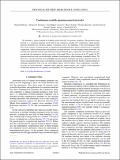Continuous-variable quantum neural networks
Author(s)
Killoran, Nathan; Bromley, Thomas R.; Arrazola, Juan Miguel; Schuld, Maria; Quesada, Nicolás; Lloyd, Seth; ... Show more Show less
DownloadPublished version (1.374Mb)
Publisher with Creative Commons License
Publisher with Creative Commons License
Creative Commons Attribution
Terms of use
Metadata
Show full item recordAbstract
We introduce a general method for building neural networks on quantum computers. The quantum neural network is a variational quantum circuit built in the continuous-variable (CV) architecture, which encodes quantum information in continuous degrees of freedom such as the amplitudes of the electromagnetic field. This circuit contains a layered structure of continuously parameterized gates which is universal for CV quantum computation. Affine transformations and nonlinear activation functions, two key elements in neural networks, are enacted in the quantum network using Gaussian and non-Gaussian gates, respectively. The non-Gaussian gates provide both the nonlinearity and the universality of the model. Due to the structure of the CV model, the CV quantum neural network can encode highly nonlinear transformations while remaining completely unitary. We show how a classical network can be embedded into the quantum formalism and propose quantum versions of various specialized models such as convolutional, recurrent, and residual networks. Finally, we present numerous modeling experiments built with the strawberry fields software library. These experiments, including a classifier for fraud detection, a network which generates tetris images, and a hybrid classical-quantum autoencoder, demonstrate the capability and adaptability of CV quantum neural networks.
Date issued
2019-10Department
Massachusetts Institute of Technology. Department of Mechanical EngineeringJournal
Physical Review Research
Publisher
American Physical Society (APS)
Citation
Killoran, Nathan et al. "Continuous-variable quantum neural networks." Physical Review Research 1, 3 (October 2019): 033063
Version: Final published version
ISSN
2643-1564